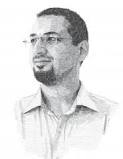Aaron Kaplan is rather in awe of being invited to the Falling Walls conference for what he calls his “hobby project”. But not all of us can boast a hobby that connects hundreds of thousands of people to the internet in a democratic, decentralised fashion. He is the founder of Funk Feuer, a peer-to-peer mesh that creates a cheap, robust, and distributed communications network.
Long before Senator Ted Stevens achieved meme fame with his description of the internet as a “series of tubes”, Bertolt Brecht opined that radio was used purely for distribution, and envisioned that if it could broadcast as well as receive, people could use this “vast network of pipes” to communicate with each other.
Despite the internet fulfilling that two-way communication dream, it is still “frighteningly centralised” according to Kaplan. Typically all users are connected through a small number of internet service providers, leading to a choke point that governments are happy to squeeze during popular protest, as Egyptian authorities did during the Arab Spring uprising. (and, it should be pointed out, the British government wanted to following the London riots)
Kaplan shows how the initial network in Austria spread to Slovenia and Serbia, eventually encompassing 600 devices spread over 240 rooftops (Funk Feuer relies on line-of-sight connectivity). Each node learns which other nodes it can “see” and reports that list to querying routers, daisy-chaining lines of communication that maintain independent, fault tolerant paths across vast distances. Because the nodes are in constant communication, they can even be placed on moving objects such as cars and planes.
But there's more to Funk Feuer than circumventing government control of the internet. The hilly, rural farmlands of Catalonia, where traditional internet infrastructure is economically unfeasible, is now home to 18,000 mesh nodes. Athens has 5,000 nodes, and boasts so many services that the internet is superfluous. The Athens team even had to build Woogle – “wireless google” – to help users navigate their way through to the service they needed.
More recently, it was Funk Feuer’s mesh networks that brought connectivity back to the decimated regions of the US east coast after Sandy struck. The low power routers, working off batteries or photovoltaic cells, kept working even after flooded generators disabled the GSM network. Not bad for a hobby project.
EDIT: Aaron writes in to add:
In the last paragraph you write: "More recently, it was Funk Feuer’s mesh networks that brought connectivity back to the decimated regions of the US east coast after Sandy struck. The low power routers, working off batteries or photovoltaic cells, kept working even after flooded generators disabled the GSM network. Not bad for a hobby project."
That's not exactly correct. It's not true that we (Funkfeuer) went there and brought back connectivity. Instead, a mesh network (implemented by Jonathan Baldwin) - based on the same principles as we use - was deployed in RedHood (NYC) already *before* the storm Sandy hit NYC. This network survived and it gave people potentially access after some of the cell phone networks had died down. These networks can potentially run on very little power, even car batteries. In the case of Redhook, electric power was still available.
- Log in to post comments



An interesting piece and an interesting idea. However, you really should consider putting some links through to relevant pages in your blog posts. I've had to go to Google and run searches on key terms, and therefore I am not too sure that I am looking at the relevant (or correct) pages.